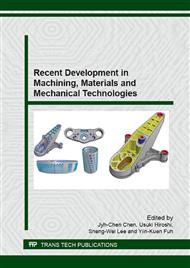p.142
p.151
p.158
p.164
p.168
p.174
p.180
p.185
p.191
Air Jet Assisted End Milling of Titanium Alloy Ti-6Al-4V ELI at High Cutting Speed
Abstract:
This paper is related to the air jet assisted machining method for a titanium alloy, Ti-6Al-4V ELI. The air jet assisted machining method is a new machining method, in which jet of the compressed air is applied to a tool tip together with flood coolant for reducing tool wear and also for extending tool life. In this experimental study, the new method was used in high-speed end milling for confirming the effect on tool life extension. Also, the optimal position of the jet nozzle was found. It was spotted that the new method is highly effective in reducing tool wear even at a high cutting speed. It is particularly noticeable that flank wear near the corner land, which is often severely damaged, was considerably reduced by the method. It turned out that the cutting forces and the degree of surface roughness observed through this method were almost the same as those through an ordinary method with flood coolant alone.
Info:
Periodical:
Pages:
168-173
Citation:
Online since:
July 2015
Authors:
Price:
Сopyright:
© 2015 Trans Tech Publications Ltd. All Rights Reserved
Share:
Citation:


